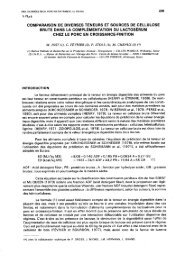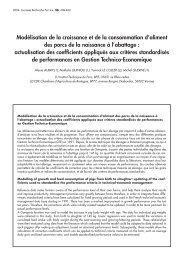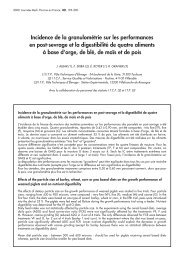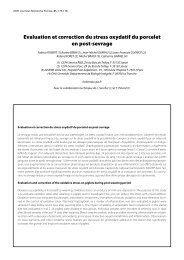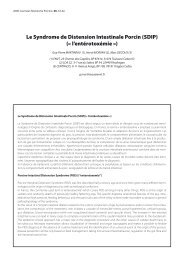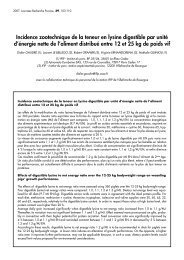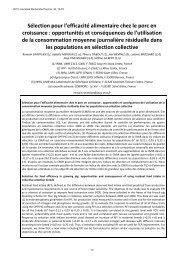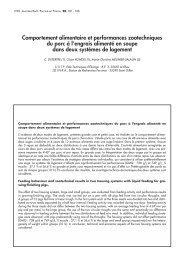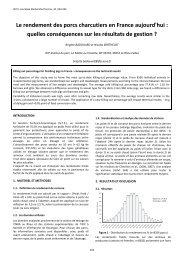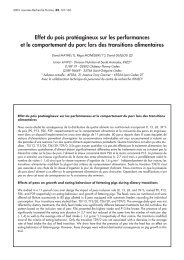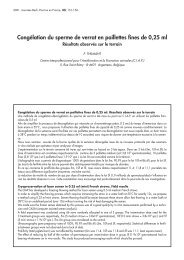Acquisition de l'immunité passive chez le porcelet : - Journées de la ...
Acquisition de l'immunité passive chez le porcelet : - Journées de la ...
Acquisition de l'immunité passive chez le porcelet : - Journées de la ...
Create successful ePaper yourself
Turn your PDF publications into a flip-book with our unique Google optimized e-Paper software.
2005. Journées Recherche Porcine, 37, 443-448.<br />
<strong>Acquisition</strong> <strong>de</strong> l’immunité <strong>passive</strong> <strong>chez</strong> <strong>le</strong> porce<strong>le</strong>t :<br />
rô<strong>le</strong> <strong>de</strong> <strong>la</strong> quantité d’immunoglobulines ingérées et <strong>de</strong> <strong>la</strong> perméabilité intestina<strong>le</strong><br />
Jean LE DIVIDICH (1), Françoise THOMAS (1), Henri RENOULT (1) et Isabel<strong>le</strong> OSWALD (2)<br />
(1) INRA-UMRVP, 35590 Saint Gil<strong>le</strong>s<br />
(2) INRA Unité <strong>de</strong> Pharmacologie-Toxicologie, 180 Chemin <strong>de</strong> Tournefeuil<strong>le</strong>, 31931 Toulouse ce<strong>de</strong>x 9<br />
<strong>Acquisition</strong> <strong>de</strong> l’immunité <strong>passive</strong> <strong>chez</strong> <strong>le</strong> porce<strong>le</strong>t : rô<strong>le</strong> <strong>de</strong> <strong>la</strong> quantité d’immunoglobulines ingérées<br />
et <strong>de</strong> <strong>la</strong> perméabilité intestina<strong>le</strong><br />
Trente porcs nouveaux nés [Piétrain x (LWxLD)] sont utilisés pour déterminer l’effef <strong>de</strong> <strong>la</strong> quantité <strong>de</strong> colostrum consommé<br />
sur l’acquisition <strong>de</strong> l’immunité <strong>passive</strong> <strong>chez</strong> <strong>le</strong> porce<strong>le</strong>t. Intra portée, 5 porce<strong>le</strong>ts sont retirés <strong>de</strong> <strong>le</strong>ur mère dès <strong>la</strong> naissance<br />
et cathétérisés. A l’issue d’une récupération <strong>de</strong> 2 heures, ils sont alimentés au biberon pendant 27 heures avec un<br />
colostrum <strong>de</strong> composition connue à raison <strong>de</strong> 70, 140, 210, 280 ou 350 g/kg <strong>de</strong> poids vif initial (PVI)/24h. Des prises<br />
<strong>de</strong> sang sont effectuées à interval<strong>le</strong>s réguliers et <strong>le</strong>s concentrations en IgG déterminées. Juste avant <strong>le</strong> quinzième repas,<br />
c’est à dire 23 heures 30 après <strong>le</strong> premier repas, on administre aux porce<strong>le</strong>ts par tubage gastrique une solution saline<br />
<strong>de</strong> <strong>de</strong>xtran marqué à l’isothiocyanate <strong>de</strong> fluorescéine (FITC-D) pour déterminer l’effet <strong>de</strong> <strong>la</strong> quantité <strong>de</strong> colostrum<br />
consommé sur <strong>la</strong> perméabilité intestina<strong>le</strong>. Dans une étu<strong>de</strong> complémentaire, 4 porcs nouveaux nés sont utilisés pour<br />
déterminer <strong>la</strong> perméabilité intestina<strong>le</strong> initia<strong>le</strong>. Les concentrations p<strong>la</strong>smatiques en insuline sont éga<strong>le</strong>ment mesurées pour<br />
examiner l’implication possib<strong>le</strong> <strong>de</strong> l’hormone dans l’arrêt du transfert <strong>de</strong>s macromolécu<strong>le</strong>s. Indépen<strong>de</strong>mment du traitement,<br />
<strong>la</strong> concentration sérique en IgG agmente linéairement à raison <strong>de</strong> 0,27 ± 0,01 mg/ml par g <strong>de</strong> colostrum<br />
consommé au cours <strong>de</strong>s 9 premières heures d’alimentation pour atteindre un p<strong>la</strong>teau <strong>de</strong> va<strong>le</strong>ur variab<strong>le</strong> selon <strong>le</strong> traitement.<br />
Les va<strong>le</strong>urs d’IgG au p<strong>la</strong>teau sont semb<strong>la</strong>b<strong>le</strong>s (26,4 ± 0,66 mg/ml) <strong>chez</strong> <strong>le</strong>s porce<strong>le</strong>ts affectés aux traitements 280<br />
et 350 et supérieur à celui atteint par <strong>le</strong>s porce<strong>le</strong>ts affectés aux autres traitements. La va<strong>le</strong>ur maxima<strong>le</strong> <strong>de</strong> 26,4 ±<br />
0,66 mg d’IgG/ml, correspond à une ingestion <strong>de</strong> 110 g <strong>de</strong> colostrum/kg PVI. Quel que soit <strong>le</strong> traiement, un pic d’insuline<br />
est observé 14,50 h après <strong>le</strong> premier repas. Sa va<strong>le</strong>ur <strong>chez</strong> <strong>le</strong>s porce<strong>le</strong>ts au plus haut niveau <strong>de</strong> colostrum est <strong>de</strong><br />
trois fois supérieure à cel<strong>le</strong> obtenue <strong>chez</strong> ceux au plus faib<strong>le</strong> niveau. La transmission intestina<strong>le</strong> du FITC-D diminue fortement<br />
avec l’âge et avec <strong>la</strong> quantité <strong>de</strong> colostrum consommé. Au moment <strong>de</strong> <strong>la</strong> mesure, el<strong>le</strong> ne représente plus que 4,3%<br />
<strong>de</strong> sa va<strong>le</strong>ur mesurée à <strong>la</strong> naissance <strong>chez</strong> <strong>le</strong>s porce<strong>le</strong>ts <strong>de</strong>s traitements 210 ou plus. El<strong>le</strong> est plus é<strong>le</strong>vée <strong>chez</strong> <strong>le</strong>s porce<strong>le</strong>ts<br />
du traiement 70, el<strong>le</strong> ne représente toutefois que 27,0 % <strong>de</strong> sa va<strong>le</strong>ur initia<strong>le</strong>. La signification d’une concentration satifaisante<br />
en IgG est discutée en re<strong>la</strong>tion avec <strong>la</strong> survie et l’acquisition d’une immunité satisfaisante.<br />
<strong>Acquisition</strong> of <strong>passive</strong> immunity in the pig<strong>le</strong>t: effects of the amount of ingested immunoglobulins<br />
and of intestinal permeability.<br />
Thirty new-born pigs were used to examine the effects of colostrum intake on the acquisition of <strong>passive</strong> immunity. Within<br />
a litter, five pigs were removed from the sow just at birth. They were catheterized and after a recovery of two hours,<br />
bott<strong>le</strong>-fed colostrum of known composition for 27 hours at the rate of 70, 140, 210, 280 or 350 g/kg initial body<br />
weight (IBW)/24h. Blood samp<strong>le</strong>s were taken to <strong>de</strong>termine serum IgG and p<strong>la</strong>sma insulin concentrations, to examine<br />
the possib<strong>le</strong> implication of the hormone in the gut closure. Prior to the 15 th feeding, i.e., at 23.5 h after the 1 st feeding,<br />
pig<strong>le</strong>ts were intra-gastrically administrated fluorescein isothiocyanate <strong>la</strong>bel<strong>le</strong>d <strong>de</strong>xtran (FITC-D) to assess the intestinal<br />
permeability to macromo<strong>le</strong>cu<strong>le</strong>s. Initial intestinal permeability was also examined at birth on four additional pigs.<br />
Irrespective of treatment, serum IgG concentrations increased linearly at the rate of 0.27 ± 0.01 mg / ml per g colostrum<br />
intake during the first 9 hours after the first feeding, and p<strong>la</strong>teaued afterwards. Values obtained at the p<strong>la</strong>teau<br />
were <strong>de</strong>pen<strong>de</strong>nt on the amount of IgG ingested. Pig<strong>le</strong>ts on treatments 280 and 350 had simi<strong>la</strong>r serum IgG concentrations<br />
at the p<strong>la</strong>teau (26.4 ± 0.66 mg/ml). This value correspon<strong>de</strong>d to 110 g colostrum/kg IBW. Regard<strong>le</strong>ss of the treatment,<br />
p<strong>la</strong>sma insulin concentrations peaked at 14.50 h after the first feed was given, with the <strong>le</strong>vel attained in pigs on<br />
treatment 350 being about 3 times higher than that attained in pigs on treatment 70. Intestinal transmission of FITC-D<br />
<strong>de</strong>creased with age and was <strong>de</strong>pen<strong>de</strong>nt on the <strong>le</strong>vel of colostrum intake. At the time of measurement, it was reduced to<br />
an average of 4.3 and 27.0% of its initial value in pigs on treatments 210, 280 and 350, and 70, respectively. The<br />
significance of the maximal serum IgG concentration is discussed in re<strong>la</strong>tion to survival and the acquisition of an a<strong>de</strong>quate<br />
<strong>passive</strong> immunity.
444<br />
INTRODUCTION<br />
Le porce<strong>le</strong>t naît complètement dépourvu <strong>de</strong> protection immunitaire<br />
(SALMON, 1984). La consommation <strong>de</strong> colostrum<br />
maternel, dans <strong>le</strong>s quelques heures qui suivent <strong>la</strong> naissance<br />
lui procure une immunité systémique (AUMAÎTRE et SEVE,<br />
1978 ; ROOKE et BLAND, 2002). Une consommation insuffisante<br />
<strong>de</strong> colostrum (énergie) est une cause majeure <strong>de</strong> <strong>la</strong><br />
mortalité néonata<strong>le</strong> provoquée par <strong>la</strong> sous-alimentation et<br />
l’hypothermie. Mais el<strong>le</strong> peut aussi conduire à un transfert<br />
insuffisant d’immunoglobulines maternel<strong>le</strong>s au nouveau-né<br />
résultant en une protection immunitaire insuffisante. Les porce<strong>le</strong>ts<br />
qui meurent à l’issue <strong>de</strong> 4-5 jours d’al<strong>la</strong>itement, présentent<br />
en effet, peu <strong>de</strong> temps après <strong>la</strong> naissance <strong>de</strong>s teneurs<br />
en immunoglobulines G (IgG) plus faib<strong>le</strong>s que <strong>le</strong>s survivants<br />
(HENDRIX et al, 1978 ; BLECHA et KELLEY, 1981 ; KOBLA-<br />
SA et al, 1981). L’acquisition d’une bonne immunité systémique<br />
semb<strong>le</strong> donc avoir une importance primordia<strong>le</strong> pour<br />
<strong>la</strong> survie et <strong>le</strong> développement <strong>de</strong>s porce<strong>le</strong>ts.<br />
L’évolution du profil en IgG sérique a été décrite <strong>chez</strong> <strong>le</strong> porce<strong>le</strong>t<br />
al<strong>la</strong>ité (JENSEN et PEDERSEN, 1979 ; KLOBASA et al,<br />
1981 ; GOMEZ et al, 1998). Cependant, à notre connaissance,<br />
aucune étu<strong>de</strong> ne rapporte <strong>le</strong>s re<strong>la</strong>tions entre ce profil<br />
et <strong>la</strong> quantité <strong>de</strong> colostrum consommé. En moyenne, cel<strong>le</strong>-ci<br />
est <strong>de</strong> 315 à 340g/kg <strong>de</strong> poids vif (LE DIVIDICH et al,<br />
1998) au cours <strong>de</strong>s premières 24 heures <strong>de</strong> vie. Mais, en<br />
réalité, el<strong>le</strong> est très variab<strong>le</strong> ainsi que l’atteste <strong>le</strong> gain <strong>de</strong><br />
poids <strong>de</strong>s porce<strong>le</strong>ts variant au sein <strong>de</strong> <strong>la</strong> portée au cours <strong>de</strong><br />
cette même pério<strong>de</strong> entre -350 et + 350g (LE DIVIDICH et al,<br />
2004), suggérant que <strong>la</strong> quantité d’IgG transférées au porce<strong>le</strong>t<br />
est aussi très variab<strong>le</strong>. Dans cette étu<strong>de</strong>, nous examinons<br />
<strong>le</strong>s effets <strong>de</strong> <strong>la</strong> quantité colostrum consommé sur <strong>le</strong> profil<br />
en IgG du porce<strong>le</strong>t au cours <strong>de</strong> sa première journée <strong>de</strong><br />
vie.<br />
1. MATÉRIELS ET MÉTHODES<br />
1.1. Animaux<br />
Trente porcs nouveaux nés (Piétrain x LW-LD) issus <strong>de</strong><br />
6 truies sont utilisés. Les mises bas sont surveillées et dès <strong>le</strong>ur<br />
naissance 5 porce<strong>le</strong>ts par portée sont isolés <strong>de</strong> <strong>le</strong>ur mère,<br />
séchés et p<strong>la</strong>cés à 32-33°C. Un cathéter est introduit dans<br />
une veine jugu<strong>la</strong>ire sous anesthésie généra<strong>le</strong>. A l’issue d’environ<br />
2 heures <strong>de</strong> récupération, <strong>le</strong>s porce<strong>le</strong>ts sont à nouveau<br />
pesés (poids vif initial, PVI) et affectés, intra-portée selon <strong>le</strong>ur<br />
PVI, à l’un <strong>de</strong>s traitements suivants : 70, 140, 210, 280 ou<br />
350g <strong>de</strong> colostrum/kg PVI/24 heures. Ils sont p<strong>la</strong>cés en<br />
cage individuel<strong>le</strong> (0,50 x 0,41 x 0,41 m) dans une sal<strong>le</strong> à<br />
température et venti<strong>la</strong>tion contrôlées. A l’issue <strong>de</strong> l’expérience,<br />
<strong>le</strong>s porce<strong>le</strong>ts sont sacrifiés afin d’examiner l’influence <strong>de</strong><br />
<strong>la</strong> quantité <strong>de</strong> colostrum consommé sur <strong>le</strong> développement <strong>de</strong><br />
l’appareil digestif (données non présentées).<br />
1.2. Alimentation<br />
Trois pools <strong>de</strong> colostrum sont obtenus à partir <strong>de</strong> plusieurs<br />
truies par traite manuel<strong>le</strong> 1-2 heures (CO), environ<br />
24 heures (C24) et 36 heures après <strong>la</strong> fin <strong>de</strong> <strong>la</strong> parturition.<br />
Afin <strong>de</strong> mimer l’évolution <strong>de</strong> <strong>la</strong> composition du colostrum au<br />
cours du premier jour après <strong>la</strong> mise bas, un colostrum intermédiaire<br />
(C12) est obtenu en mé<strong>la</strong>ngeant volume à volume<br />
du C0 et du C24. De même un C30 est obtenu en mé<strong>la</strong>ngeant<br />
du C24 et du C36 (2/1). Les divers colostrum sont<br />
ensuite répartis en portions <strong>de</strong> 70-100 g et congelés. La<br />
congé<strong>la</strong>tion conserve en effet <strong>le</strong>s qualités nutritionnel<strong>le</strong>s et<br />
immunes du colostrum (KLOBASA et al, 1998). Les porce<strong>le</strong>ts<br />
sont alimentés au biberon à interval<strong>le</strong> d’une heure pendant<br />
<strong>le</strong>s 6 premières heures et ensuite toute <strong>le</strong>s 2 heures pendant<br />
20 heures. Au total, <strong>le</strong>s porce<strong>le</strong>ts reçoivent 17 repas : 7 <strong>de</strong><br />
C0 suivis <strong>de</strong> 4 <strong>de</strong> C12, 4 <strong>de</strong> C24 et 2 <strong>de</strong> C30. Avant<br />
chaque distribution, <strong>le</strong> colostrum est réchauffé à 37°C. Le<br />
volume <strong>de</strong> chaque repas est doublé lorsque l’interval<strong>le</strong> entre<br />
chaque repas passe à 2 heures. La quantité <strong>de</strong> colostrum<br />
consommé est déterminée par pesée (± 0,1g) du biberon<br />
avant et après chaque repas. La composition <strong>de</strong>s colostrum<br />
est présentée au tab<strong>le</strong>au 1. Pour déterminer l’effet <strong>de</strong> <strong>la</strong><br />
quantité <strong>de</strong> colostrum consommé sur <strong>la</strong> perméabilité intestina<strong>le</strong>,<br />
chaque porce<strong>le</strong>t reçoit par tubage gastrique, en même<br />
temps que <strong>le</strong> 15 ème repas, une solution saline <strong>de</strong> <strong>de</strong>xtran<br />
(20mg/ml) marqué à l’isothiocyanate <strong>de</strong> fluorescéine<br />
(FITC-D 70, PM : 70000 dalton), à raison <strong>de</strong> 10ml/kg <strong>de</strong><br />
poids corporel. Dans une étu<strong>de</strong> complémentaire, 4 porcs<br />
nouveaux nés sont utilisés pour déterminer <strong>la</strong> perméabilité<br />
intestina<strong>le</strong> initia<strong>le</strong>. Le FITC-D est administré, lors du 1 er repas,<br />
<strong>de</strong> <strong>la</strong> même manière que précé<strong>de</strong>mment. Les porce<strong>le</strong>ts sont<br />
nourris toutes <strong>le</strong>s heures pendant 9 heures à raison <strong>de</strong> 250g<br />
<strong>de</strong> colostrum / kg PVI / 24 heures.<br />
1.3. Prises <strong>de</strong> sang et analyses<br />
El<strong>le</strong>s sont effectuées environ 30 mn avant <strong>le</strong> 1 er , 2 ème , 3 ème ,<br />
5 ème , 8 ème , 11 ème et 15 ème repas, puis 90 min après <strong>le</strong> <strong>de</strong>rnier<br />
repas. Après coagu<strong>la</strong>tion d’une partie <strong>de</strong> chaque échantillon,<br />
<strong>le</strong> sérum est séparé par centrifugation, pré<strong>le</strong>vé et<br />
congelé. Une autre partie pré<strong>le</strong>vée sous héparine est rapi<strong>de</strong>ment<br />
centrifugée et <strong>le</strong> p<strong>la</strong>sma congelé. Sur <strong>le</strong>s 4 animaux<br />
complémentaires, <strong>de</strong>s prises <strong>de</strong> sang sont aussi effectuées<br />
environ 30 min avant <strong>le</strong>s repas 2 à 9 et 30 min après <strong>le</strong> <strong>de</strong>rnier<br />
repas. L’analyse <strong>de</strong>s colostrum est effectuée selon <strong>le</strong>s<br />
métho<strong>de</strong>s précé<strong>de</strong>mment décrites (LE DIVIDICH et al, 1991).<br />
Les IgG colostraux et sériques sont déterminés par <strong>la</strong> métho<strong>de</strong><br />
ELISA selon PINTON et al, (2004) et <strong>le</strong> FITC-D par fluorimétrie<br />
(WESTRÖM et al, 1984). Enfin, sur <strong>le</strong>s porce<strong>le</strong>ts <strong>de</strong>s<br />
lots 70, 210 et 350, l’insuline p<strong>la</strong>smatique est déterminée<br />
par RIA à l’ai<strong>de</strong> d’un kit CIS bio International-Oris (France)<br />
afin <strong>de</strong> vérifier l’implication possib<strong>le</strong> <strong>de</strong> cette hormone dans<br />
l’arrêt du transfert intestinal <strong>de</strong>s macromolécu<strong>le</strong>s (SVEND-<br />
SEN et al, 1986).<br />
Tab<strong>le</strong>au 1 - Composition chimique <strong>de</strong>s colostrum<br />
Colostrum<br />
CO C12 C24 C30<br />
Humidité, % 76,5 77,0 77,7 76,4<br />
Protéines, (Nx6,38) % 14,1 12,2 10,2 9,1<br />
Lipi<strong>de</strong>s, % 5,6 6,6 7,6 9,2<br />
Lactose, % 3,2 3,4 3,5 4,1<br />
Energie brute, kJ/g 6,1 6,0 6,2 6,6<br />
IgG, g ‰ 66,0 42,7 22,4 16,2
445<br />
1.4. Analyse statistique<br />
Les différences <strong>de</strong> concentrations en IgG et en insuline sont<br />
testées par <strong>la</strong> métho<strong>de</strong> <strong>de</strong>s “mesures répétées”. En outre,<br />
nous avons rapporté <strong>le</strong>s concentrations sériques en IgG <strong>de</strong>s<br />
porce<strong>le</strong>ts en fonction <strong>de</strong> <strong>la</strong> quantité cumulée <strong>de</strong> colostrum<br />
ingéré. A l’exception du lot 70, ces re<strong>la</strong>tions sont décrites<br />
comme une fonction linéaire-p<strong>la</strong>teau avec <strong>la</strong> même pente et<br />
un p<strong>la</strong>teau commun aux traitements 280 et 350. L’analyse<br />
est effectuée à l’ai<strong>de</strong> <strong>de</strong> <strong>la</strong> procédureNLIN du logiciel SAS<br />
(1990).<br />
2. RÉSULTATS<br />
Le poids moyen initial <strong>de</strong>s porce<strong>le</strong>ts <strong>de</strong>s 5 groupes est <strong>de</strong><br />
1416 (± 59) g (tab<strong>le</strong>au 2). Le gain <strong>de</strong> poids (Y, g) augmente<br />
<strong>de</strong> manière linéaire (P
446<br />
étant plus <strong>de</strong> 3 fois plus é<strong>le</strong>vée (70,0 (± 59) vs 20,7 (± 59),<br />
P < 0,01) que cel<strong>le</strong> atteinte par <strong>le</strong> groupe 70. Parallè<strong>le</strong>ment,<br />
<strong>la</strong> glycémie (données non présentées) augmente d’une va<strong>le</strong>ur<br />
initia<strong>le</strong> <strong>de</strong> 0,56 g/l jusqu’à un p<strong>la</strong>teau atteint 14h30 après<br />
<strong>le</strong> premier repas. Les va<strong>le</strong>urs au p<strong>la</strong>teau <strong>chez</strong> <strong>le</strong>s porce<strong>le</strong>ts<br />
<strong>de</strong>s groupes 70, 210 et 350 sont respectivement 1,10<br />
(± 0,10), 1,25 (± 0,07) et 1,48 (± 0,05) g/l. Les différences<br />
sont toutes significatives (P < 0,05).<br />
2.3. Transfert du FITC-D<br />
Chez <strong>le</strong> nouveau-né, <strong>la</strong> concentration sérique du FITC-D<br />
augmente <strong>de</strong> manière curvilinéaire (P
447<br />
JACOBSEN et al, 2002). Il est alors possib<strong>le</strong> que <strong>le</strong>s différences<br />
<strong>de</strong> concentrations maxima<strong>le</strong>s d’IgG <strong>chez</strong> <strong>le</strong>s porce<strong>le</strong>ts<br />
soient dues à <strong>de</strong>s différences <strong>de</strong> concentrations initia<strong>le</strong>s <strong>de</strong>s<br />
colostrums en IgG. Dans notre étu<strong>de</strong>, el<strong>le</strong>s sont simi<strong>la</strong>ires à<br />
cel<strong>le</strong>s <strong>de</strong> 58 à 70 mg/ml rapportées par JENSEN et PEDER-<br />
SEN (1979), BLAND et al, (2003) et LE DIVIDICH et al,<br />
(2004), mais plus faib<strong>le</strong>s que cel<strong>le</strong>s <strong>de</strong> 86 à 96 mg/ml rapportées<br />
par BOURNE (1969) et KLOBASA et al (1987).<br />
Selon certains auteurs (HENDRIX et al, 1978 ; KOBLASA et<br />
al, 1981), <strong>le</strong>s porce<strong>le</strong>ts qui meurent avant <strong>le</strong> sevrage ont <strong>de</strong>s<br />
taux d’IgG sériques <strong>de</strong> 10 à 50 % inférieurs à ceux <strong>de</strong>s survivants.<br />
On peut alors se <strong>de</strong>man<strong>de</strong>r dans quel<strong>le</strong> mesure <strong>la</strong><br />
concentration maxima<strong>le</strong> en IgG au p<strong>la</strong>teau correspond à une<br />
immunité <strong>passive</strong> satisfaisante. Chez <strong>le</strong> veau, une concentration<br />
éga<strong>le</strong> ou supérieure à 15 mg/ml est considérée comme<br />
suffisante pour assurer une bonne protection contre <strong>le</strong>s infections<br />
(PERINO et al, 1995 ; WITTUM et PERINO, 1995). Chez<br />
<strong>le</strong>s porce<strong>le</strong>ts, COALSON et LECCE (1973) suggèrent qu’“une<br />
heure <strong>de</strong> tétée d’un colostrum <strong>de</strong> bonne qualité immune” est<br />
suffisante pour <strong>le</strong>ur procurer une immunité <strong>passive</strong> satisfaisante<br />
correspondant à 15-17 mg IgG/ml. Selon l’équation 2, ce<br />
niveau d’IgG peut être acquis par une ingestion <strong>de</strong> seu<strong>le</strong>ment<br />
70 g <strong>de</strong> colostrum, <strong>de</strong> bonne qualité immune/kg PVI (soit<br />
98 g pour <strong>de</strong>s porce<strong>le</strong>ts pesant 1,400 kg, en moyenne) dans<br />
<strong>le</strong>s quelques heures suivant <strong>la</strong> naissance. Mais, à cette quantité<br />
<strong>de</strong> colostrum consommé correspond, d’après l’équation 1,<br />
un gain <strong>de</strong> poids négatif (-40 g) <strong>de</strong>s porce<strong>le</strong>ts entre <strong>la</strong> naissance<br />
et 24 heures ce qui constitue un facteur <strong>de</strong> risque pour<br />
<strong>le</strong>ur survie (LE DIVIDICH et al, 2004). En d’autres termes, l’acquisition<br />
d’une immunité <strong>passive</strong> satisfaisante n’est pas une<br />
garantie <strong>de</strong> survie <strong>de</strong>s porce<strong>le</strong>ts. D’ail<strong>le</strong>urs, selon TYLER et al,<br />
(1990), <strong>le</strong> taux d’IgG entre 48 et 60 heures d’âge ne serait<br />
qu’un médiocre prédicteur <strong>de</strong> <strong>la</strong> survie <strong>de</strong>s porce<strong>le</strong>ts. Ceci est<br />
aussi illustré par <strong>le</strong>s résultats <strong>de</strong> DEVILLERS (2004) montrant<br />
que <strong>le</strong>s porce<strong>le</strong>ts qui meurent dans <strong>le</strong>s trois premiers jours <strong>de</strong><br />
vie ont, à 24h d’âge, un taux d’IgG acceptab<strong>le</strong>, soit<br />
15,4mg/ml <strong>de</strong> sérum, mais ne consomment, en moyenne, que<br />
70 g <strong>de</strong> colostrum. Selon cet auteur, une consommation d’environ<br />
200 g <strong>de</strong> colostrum serait nécessaire pour fournir suffisamment<br />
d’énergie pour <strong>la</strong> survie <strong>de</strong>s porce<strong>le</strong>ts. Mais, une<br />
ingestion <strong>de</strong> colostrum en quantité suffisante pour couvrir <strong>le</strong><br />
besoin en énergie du porce<strong>le</strong>t, lui apporterait éga<strong>le</strong>ment suffisamment<br />
d’immunoglobulines pour une protection immunitaire<br />
satisfaisante.<br />
Remerciements à Y. Lebreton pour <strong>la</strong> préparation chirurgica<strong>le</strong><br />
<strong>de</strong>s porce<strong>le</strong>ts.<br />
RÉFÉRENCES BIBLIOGRAPHIQUES<br />
• AUMAÎTRE A., SÈVE B., 1978. Ann. Rech. Vet., 9, 181-192.<br />
• BATE, L.A. HACKER R.R., 1985. Can. J Anim. Sci., 65, 77-85.<br />
• BESSER T.E., GARMEDIA A.E., McGUIRE T.C., GAY C.C., 1985. J Dairy Sci., 68, 2033-2037.<br />
• BLAND I.M., ROOKE J.A., BLAND V.C., SINCLAIR A.G., EDWARDS S.A., 2003. Anim. Sci. 77, 277-286.<br />
• BLECHA F., KELLEY K.W., 1981. J. Anim. Sci., 52, 594-600.<br />
• BOURNE F.J., 1969. Anim. Prod., 11, 337-343.<br />
• COALSON J.A., LECCE J.G., 1973. J. Anim. Sci. 36, 381-385.<br />
• DEVILLERS N., 2004. Variabilité <strong>de</strong> <strong>la</strong> production colostra<strong>le</strong> <strong>chez</strong> <strong>la</strong> truie. Origine et conséquences pour <strong>la</strong> survie du porce<strong>le</strong>t. Thèse <strong>de</strong><br />
Doctorat <strong>de</strong> l’Université <strong>de</strong> Rennes (179 p).<br />
• DONOVAN T.S., DRITZ S.S., 2000. JAVMA., 217, 79-80.<br />
• GOMEZ, G.G., PHILIPS, O., GOFORD, R.G., 1998. J. Anim. Sci. 76, 1-7.<br />
• HENDRIX W.F., KELLEY K.W. GASKINS C.T., HINRICHS D.J., 1978. J. Anim. Sci., 1281-1286.<br />
• JACOBSEN H., SANGILD P.T., SCHMIDT M., HOLN P., GREVE T., CALLENSEN H., 2002. Anim. Reprod. Sci., 70, 1-11.<br />
• JENSEN P.T., PEDERSEN K.B., 1979. Acta vet. Scand. 20, 60-72.<br />
• JENSEN A., R., ELNIF J., BURRIN D.G., SANGILD P.T., 2001. J Nutr., 131, 3259-3265.<br />
• KOBLASA F., WERHAHN E., BUTHER JE., 1981. Res. Vet. Sci., 31, 195-206.<br />
• KOBLASA F., WERHAHN E., BUTLER J.E., 1987. J Anim. Sci., 65, 1458-1466.<br />
• KOBLASA F., GOEL M.C., WERHAHN E., 1998. J Anim. Sci., 76, 923-926.<br />
• LEARY H.L., LECCE J.G., 1978. Biol. Neonate, 34, 174-176.<br />
• LECCE J.G., MORGAN D.G, 1962. J. Nutr., 78, 263-268.<br />
• LE DIVIDICH J., ESNAULT Th., LYNCH B., HOO-PARIS R., CASTEX Ch. PEINIAU J. 1991., J Anim. Sci., 79, 2480-2488.<br />
• LE DIVIDICH J., NOBLET J., HERPIN P., van MILGEN J., QUINIOU N., 1998. In: Progress in Pig Science, Wiseman J., Var<strong>le</strong>y M.A., Charlick<br />
J.P. (Eds), Nottingham University Press, pp 229-263.<br />
• LE DIVIDICH J., MARTINEAU G.P., THOMAS, F., DEMAY H., RENOULT H., HOMO Ch., BOUTIN D., GAILLARD L., SUREL Y., BOUETARD<br />
R., MASSARD M., 2004. Journées Rech. Porcine, 36, 451-456.<br />
• MACHADA-NETO R., GRAVES C.N., CURTIS, S.E., 1987. J Anim. Sci., 65, 445-455.<br />
• MURATA H., NAMIOKA S., 1977. J. Comp. Path., 87, 431-439.<br />
• PERINO L.J., WITTUM T.E., ROSS G.S. 1995. Am. J. Vet .Res. 56, 114-118.<br />
• PINTON P., ROYER E., ACCENSI F., MARIN D., GUELFI J.F., BOURGES-ABELLA N., GRANIER R., GROSJEAN F., OSWALD I.P., 2004.<br />
Journées Rech. Porcine, 36, 301-308.<br />
• ROOKE J.A., BLAND I.M., 2002. Livest. Prod. Sci., 78, 12-23.<br />
• SALMON H., 1984. Reprod. Nutr. Dev., 24, 197-206.<br />
• SVENDSEN L.S., WESTRÖM BR., SVENDSEN J., OHLSSON BG., EKMAN R., KARLSSON BW., 1986. J. Pediatr. Gastroenterol. Nutr. 5,<br />
299-304.<br />
• TYLER J.W., CULLOR J., THURMOND M.C., DOUGLAS V.L., PARKER K.M., 1990. Am. J. Vet. Res., 51, 1400-1406.<br />
• WERHAHN E., KLOBASA F., BUTLER J.E., 1981. Vet. Immunol. Immunopathol. 2, 35-51.<br />
• WESTRÖM BR., SVENDSEN J., OHLSSON BG., TAGESSON C. KARLSSON BW., 1984. Biol. Neonate, 46, 20-26.<br />
• WITTUM Th.E., PERINO L.J., 1995. Am. J. Vet .Res., 56, 1149-1154.



